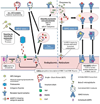Therapeutic HPV DNA vaccines
- PMID: 20066511
- PMCID: PMC2891127
- DOI: 10.1007/s12026-009-8141-6
Therapeutic HPV DNA vaccines
Abstract
It is now well established that most cervical cancers are causally associated with HPV infection. This realization has led to efforts to control HPV-associated malignancy through prevention or treatment of HPV infection. Currently, commercially available HPV vaccines are not designed to control established HPV infection and associated premalignant and malignant lesions. To treat and eradicate pre-existing HPV infections and associated lesions which remain prevalent in the U.S. and worldwide, effective therapeutic HPV vaccines are needed. DNA vaccination has emerged as a particularly promising form of therapeutic HPV vaccines due to its safety, stability and ability to induce antigen-specific immunity. This review focuses on improving the potency of therapeutic HPV vaccines through modification of dendritic cells (DCs) by [1] increasing the number of antigen-expressing/antigen-loaded DCs, [2] improving HPV antigen expression, processing and presentation in DCs, and [3] enhancing DC and T cell interaction. Continued improvement in therapeutic HPV DNA vaccines may ultimately lead to an effective DNA vaccine for the treatment of HPV-associated malignancies.
Figures




References
-
- Parkin DM, Bray F, Ferlay J, Pisani P. Global cancer statistics, 2002. CA Cancer J Clin. 2005;55:74–108. - PubMed
-
- Walboomers JM, Jacobs MV, Manos MM, Bosch FX, Kummer JA, Shah KV, et al. Human papillomavirus is a necessary cause of invasive cervical cancer worldwide. J Pathol. 1999;189:12–19. - PubMed
-
- Smith JS, Lindsay L, Hoots B, Keys J, Franceschi S, Winer R, et al. Human papillomavirus type distribution in invasive cervical cancer and high-grade cervical lesions: a meta-analysis update. Int J Cancer. 2007;121:621–632. - PubMed
-
- de Villiers EM, Fauquet C, Broker TR, Bernard HU, zur Hausen H. Classification of papillomaviruses. Virology. 2004;324:17–27. - PubMed
-
- Tindle RW. Immune evasion in human papillomavirus-associated cervical cancer. Nat Rev Cancer. 2002;2:59–65. - PubMed
